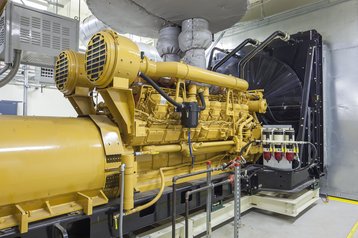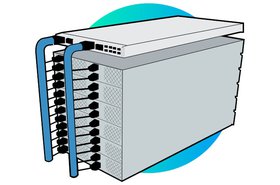Once you adopt the latest cooling technologies, use renewable energy to power or offset a facility’s operations, and generally utilize the myriad of ways available to reduce the PUE of a data center, diesel-glugging backup generators stick out as one of the last bastions of ongoing pollution.
But uptime and availability are critical, so it’s difficult to eliminate your main means of providing backup power. In a crisis, generators are quick to start, and diesel fuel is easy to source. While many companies are looking at swapping them for fuel cells, few if any have made it work on a large scale.
However, even if companies aren’t ready to ditch generators, perhaps they can ditch the diesel that fuels them. In July, UK data center firm Kao Data announced it was partnering with Crown Oil to replace its diesel reserves for its backup generators with hydrotreated vegetable oil (HVO) fuel.
The company will replace an initial 45,000 liters of diesel and switch to an HVO provision of more than 750,000 liters when its Harlow campus is fully developed.
Gerard Thibault, Kao’s chief technical officer told DCD that the company chose to take this route in order to reduce its carbon footprint and boost its sustainability efforts.
“What we're trying to do is reduce the amount of energy in the first place being consumed by the facility,” he said “Kao Data is really invested wholeheartedly in trying to drive efficiency and sustainability. “COP26 is coming. Everybody really should be targeting getting to net-zero. And this is one way that we can certainly take some steps to get there.” COP26 is the United Nations’ climate summit, coming to Glasgow in November.
This article appeared in our Critical Power Supplement. Read the whole thing here
What is Hydrotreated Vegetable Oil (HVO)?
Synthesized from vegetable oils, Hydrotreated Vegetable Oil is a type of biodiesel where hydrogen is added to the oil.
Such ‘green diesels’ create fewer emissions than regular fuel; Crown Oil says 1,000 liters of HVO releases 195kg of C02, compared to 3,600kg for the same amount of regular diesel.
“In simple terms, HVO fuel is made from waste product produced from kitchens and food production from frying oil. Residues, edible fats and oily waste water which would otherwise be discarded and disposed of are instead put to another use,” says Chris Beatty, sales director at Crown Oil Environmental. “Rather than be disposed of in a landfill, materials are transported to factories where a hydrotreatment process is used to produce the advanced synthetic renewable fuel.”
While biofuels have been on the market for a number of years, recent improvements in development means newer fuels such as HVO don’t have many of the performance, storage, or maintenance issues of previous biofuels, which is making them more popular and viable for mission critical use-cases.
“Biofuels have obviously come a long way since they first hit the market and we are seeing clear improvements in development over the last four to five years,” says Beatty. “HVO is a second-generation biofuel which does not have the operational issues of previously introduced first generation biofuels as it’s FAME-free (Fatty Acid Methyl Esters) and 100 percent bio.”
While some biofuels are synthesized from produce – palm, sugarcane, soybeans etc. – grown specifically to harvest for fuel, the treated oil in HVO is usually sourced from the likes of tall oil [a by-product of wood pulp manufacture], rapeseed oil, waste cooking oil, and animal fats.
This means it has less impact on agricultural land, and avoids the negative environmental reputation of palm oil, which is often grown in plantations displacing cleared rainforests.
“The life cycle emissions of products produced from waste and residues are typically much smaller than those produced from virgin vegetable oils, and significantly smaller than lifecycle emissions of fossil oil based alternatives,” explains Crown’s Beatty. “Further development includes the availability of emerging low-quality waste and residual raw materials, such as municipal solid waste, algae, and power-to-liquids.”
Global manufacturer Neste supplies the HVO, and Crown is its only distributor in the UK – though other suppliers can provide HVO from other manufacturers.
Crown says it does not support the use or sale of palm oil-derived HVO, its renewable diesel product does not contain any products that contribute to global deforestation and is derived from 100 percent waste products.
HVO can be stored at higher and lower temperatures than diesel, and can reportedly be stored for up to 10 years and is less likely than other fuels to see any microbial growth. HVO is billed as a ‘drop in’ fuel, which means using it shouldn’t need any additional modifications to existing engines, and in early testing with Crown, Thibault said Kao is seeing particulate emissions reduced by between 20 and 50 percent.
“HVO reduces the net CO2 emissions by 90 percent. There's no sulfur dioxide emitted as you would see with other diesel products. NOx emissions are also reduced by 10 to 30 percent.
“And we're taking a product that has been used, grown for food stuffs and used in the preparation, the cooking of foodstuffs. It's been reclaimed and recycled before we then get to use it.”
Thibault acknowledges that HVO is around 25 percent more expensive than diesel. This could be offset by savings elsewhere, as HVO needs less storage maintenance, and early tests suggest it gives more generator runtime per liter - but overall the company has chosen to ‘take the hit’ for the environmental gains.
“Obviously as your estate grows and your load grows, that's still going to be an appreciable amount of money, but we feel it's the right thing to be doing as stewards of the industry,” says Thibault. “We've taken it because we think it's the right thing to do. And we should be leading the market, everybody else can follow without detriment to their investment in equipment.”
Kao ditches diesel
Kao already has a Renewable Energy Guarantees of Origin (REGO) certificate from EDF to offset its energy use and while it is looking at newer battery technologies for its UPS systems, and saw an opportunity for an easy sustainability gain through changing fuels.
“Our generators only run for a total of something like 24 hours in a typical year; about two hours a month on testing. They're not using huge volumes of fuel, but I think it's incumbent upon anybody in this sector to reduce the effect that they do have, no matter how short their runtime is."
“Those hours still add up to quite a number of liters of fuel. And so that's a huge win for very little expense.”
While it is a ‘drop-in’ fuel, Kao conducted nearly 12 months of testing with Crown Oil alongside Rolls-Royce, its subsidiary MTU, and AVK to confirm that generator performance and health weren’t adversely affected by HVO.
“We spent and invested time and energy in looking at ‘does it affect our reliability?’ Rolls Royce spent a lot of time sort of thinking about it, analyzing it. And no it doesn't; it really is a drop-in fuel. ”
“We've actually got some evidence that the increased cetane number of the fuel [a measure of diesel fuel quality] actually potentially gives us slightly more energy out of each liter of fuel. I don't think it will ever offset the increasing fuel cost, but it does mean that potentially we use less fuel than we would if it was fossil fuels.”
As it's a newer fuel, HVO isn’t as easily sourced as regular diesel, but Crown has reportedly guaranteed there is more than ample supply both for Kao and other UK data center operators.
According to the International Energy Agency, there were around 9 billion liters of HVO produced globally in 2020, up from 7 billion in 2019. The IEA reports HVO capacity is also expected to be 50 percent higher in 2021 than in 2020 if new projects are built on schedule, and biofuel production (including HVO) is expected to be seven percent higher in 2022 than in 2021.
“We have checked that our reserve supplier can also give us an unrestricted supply of HVO as well so we made sure that we're not single-sourced,” notes Thibault. “And the more people that use it, like most things, the more will be produced.”
HVO versus fuel cells and other biofuels
A number of companies are looking at the likes of hydrogen and fuel cells for backup power, with Equinix even considering Bloom fuel cells as its primary energy source at one facility.
When asked why Kao chose to replace the fuel rather than invest in newer technologies, Thibault said the company looked at hydrogen and fuel cells, and thought they weren’t ready for use yet.
“We've invested in diesel generators. It doesn't make financial sense or even perhaps sustainable sense to just bin those off,” says Thibault. “But if we can use them in a much more environmentally friendly way, we think that actually pound for pound as an investment for the amount of sustainability advantage it gives us, it's a great way of making some very quick gains in that area.”
Fuel cells and generators are both only as green as the fuel they burn, says Professor Sanjoy Banerjee of the City University of New York. He describes fuel cells as “glorified generators” unless they use green hydrogen fuel, and points out that generators burning green fuel can be an equally low-emission power source.
Preserving the financial investment made in the generators keeps investors happy, while the environmental investment in the materials used to make the generators isn’t wasted by replacing them before their end of life.
When asked specifically why HVO versus other biodiesels, Kao reportedly didn’t consider any other ‘green fuels’ based on past experiences. Thibault says he has worked with other types before in previous roles, and such FAME (Fatty Acid Methyl Esters) fuels can see increased biomicrobe growth in the fuel tanks, resulting in sludge and performance issues. He noted in one facility the use of biofuels led to a near-constant process of polishing in order to keep the fuel clean.
“We [at Kao previously] took the decision to fit fuel polishing on all of our engines anyway to make sure the diesel was always in perfect condition, but what we're finding is that we don't need to do that polishing any more [with HVO]. So that's another pump that doesn't have to run for hours on a cycle to keep it in absolutely peak condition.”
Crown Oil says the product is relatively new to the UK market, and the company has previously encountered a “better the devil you know” attitude amongst some buyers.
“HVO is a relatively new fuel to the market which naturally carries some hesitation from users who are tentative about the product and its performance,” says Beatty. “It is also a more costly product than diesel which will also put off cost-buyers. There is some distrust regarding previous generations of biofuel also which we need to move past, but since the announcement of the legislation change in duty rates for diesel next April, a lot of companies are now looking to make the switch.”
Assuming a company is willing to take the price hit, it seems there are few downsides to adopting HVO. But why haven’t more data center companies taken the move to ditch diesel?
“I don't know; maybe it's resisting change, maybe they've just not been made aware of it,” says Thibault. “Because we're so focused on sustainability and Crown we're so persistent in pushing it, we found a common interest.
“Hopefully having raised that awareness, it will give people the impetus to go and do that. In my mind, it's a relatively small financial hit for something that is clearly going to benefit the environment.”
Backup beyond fuel and backup generators; coding for resiliency
In the long-term, Thibault hopes the industry can encourage more focus on using software-based backup and resiliency that reduces the need for backup generators altogether - and addresses the efficiency of the IT in the facility.
Power usage effectiveness (PUE) measures how much power is used in the site as a whole, compared to the power that reaches the racks. If PUE is 1.2, say, then for every 1kW used by the IT, 200W is used elsewhere, mostly in cooling. For a colo provider, the IT power (the initial 1 in the PUE) is down to their customers.
“We ourselves can’t directly affect the 1 of the PUE,” he says. “I think there should be quite a lot of focus around improving the efficiency of the code to really make that initial '1' the most efficient that it can be.”
Thibault suggests data center firms should work with customers to look at different ways of backing up applications and using the software to do the failover scenarios that can rely on short-term UPS and batteries to keep apps running until they've done the transfer if they really do need a full migration to a backup site.
“Maybe that won't suit every web-hosted application, but it may well suit a lot if we can rely just on UPS to hold it up for 5-10 minutes and then move the application to where there isn't a power outage. Those are the types of things that I think we should, as an industry, be looking at.
“Let's do away with generators; they're very expensive, they drive up the cost of building data centers, they drive up effectively the result in total cost of ownership for customers because that cost has to be passed on.”









